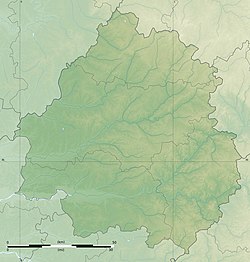Venus of Tursac
Coordinates: 44 ° 58 '38.6 " N , 1 ° 3' 13.9" E
| Venus of Tursac | ||
|---|---|---|
| location | Tursac , Dordogne , France | |
| Find in | Abri du Facteur | |
|
|
||
| Dimensions | Height 80 mm
Width 22 mm Thickness 37 mm |
|
| When | Gravettias | |
The Venus de Tursac is a paleolithic Venus figurine that was found on August 5, 1959 by Robert Antoine-Charles and Henri Delporte during an excavation in the Abri du Facteur, municipality of Tursac , in the Dordogne department in France .
The figurine is eight centimeters high, weighs 57.5 grams and is made of calcite . The headless body of a presumably female person is shown. The upper body ends in a rounded tenon, there are no arms. The woman's legs are bent under the lower body and the buttocks appear to be erect. This posture, which is medically to be regarded as a lumbar lordosis (lumbar vertebral hollow cross ), is interpreted by Russel Dale Guthrie as an invitation to sexual intercourse. Between the legs, protruding downward or backward from the pelvis, is a cone-shaped structure. The cone is interpreted by Gerhard Bosinski and Wolf Günter Haensch as a birth process.
Due to the well-documented stratigraphy , the Venus of Tursac can be precisely timed. According to the investigations by Henri Delporte, the radiocarbon age of the find layer is between 24,720 ± 600 and 24,210 ± 500. This corresponds to 27,535 ± 746 cal. BCE and 27,115 ± 610 cal. BCE and thus falls into the Gravettia .
Striking similarities in shape and choice of materials suggest that the Venus of Tursac and the Venus of Sireuil were either created by the same artist or emerged from the same artistic tradition / school.
The figure is in the Musée d'Archéologie nationale in Saint-Germain-en-Laye .
literature
- Henri Delporte : Une nouvelle statuette paléolithique: la Vénus du Tursac. In: L'Anthropologie. Vol. 63, No. 3-4, 1959, pp. 232-245
- Henri Delporte: Observations paleo-topographiques on the Vénus de Tursac (“La belle et la bête”). In: Bulletin de la Société préhistorique de France. Vol. 59, Nos. 11-12, 1962, pp. 813-818 ( online ).
- Henri Delporte: L'Abri du Facteur a Tursac (Dordogne). In: Gallia Préhistoire. Volume 11, Faszikel 1, 1968, pp. 97-107.
- Jean-Pierre Duhard: Étude comparative des statuettes féminines de Sireuil et Tursac (Dordogne). In: Gallia préhistoire. Volume 35, 1993, pp. 283-291 ( online ).
Web links
- La vénus de Tursac , website of the Musée d'Archéologie nationale
- Venus de Tursac (English)
Remarks
- ↑ Wolf Günter Haensch : The human statuettes of the middle Upper Palaeolithic from the point of view of somatic anthropology (= Antiquitas. Series 2, Volume 12). Habelt, Bonn 1982, p. 64.
- ↑ Russel Dale Guthrie: The Nature of Paleolithic Art. University of Chicago Press, Chicago 2005, p. 352.
- ^ Gerhard Bosinski: Art in every form. Of cave pictures and female figures in Gravettia. In: Ice Age, Art and Culture. Accompanying volume for the exhibition Ice Age - Art and Culture in the Stuttgart Art Building, September 18, 2009 - January 10, 2010 . Thorbecke, Ostfildern 2009, pp. 272–277, here p. 277; Wolf Günter Haensch: The human statuettes of the middle Upper Palaeolithic from the perspective of somatic anthropology (= Antiquitas. Row 2, Volume 12). Habelt, Bonn 1982, p. 64.
- ↑ Randall White: Une nouvelle statuette phallo-féminine paléolithique: "La Vénus de Milandes" (commune de Castelnaud-la-Chapelle, Dordogne). In: PALEO. Volume 14, 2002, pp. 177-198, here: p. 190.
- ↑ Jean-Pierre Duhard: Étude comparative of statuettes féminines de Sireuil et Tursac (Dordogne). In: Gallia préhistoire. Volume 35, 1993, pp. 283-291.


